|
Children learn and adults reflect
at the “Journey to the Cross” at JeffStreet Church
 Send a link to a friend
Send a link to a friend
[March 24, 2024]
On Saturday, March 23, JeffStreet Christian Church
hosted Journey to the Cross.
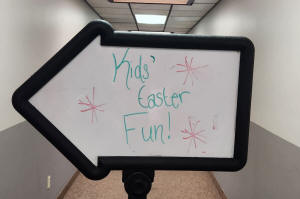
In the old sanctuary, now known as the well, children
accompanied by adults had a chance to experience the meaning of
Easter and hunt for 4,000 eggs.
Minda Alben wanted to provide a children’s version of Jesus’ journey
to the cross. Using some curriculum, Alben made it more interactive
for the children to help them understand the journey Jesus took to
the cross.
When families first entered the well, a table was set up for
children to decorate bags to hold the eggs they would find
throughout the room.
Next was a station where children were blindfolded and tried to pin
the tail on the donkey. This part represented Jesus coming to
Jerusalem to celebrate Passover. When he entered the city riding a
donkey, crowds went out with palm branches praising Jesus.
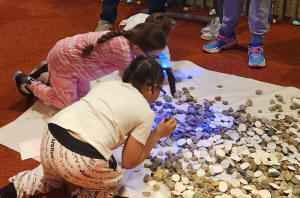
At the third station, children used a flashlight to
find a glowing rock in a pile of rocks. The rock represented their
sins, and they were to carry the rock through the rest of the
journey and then drop it into a tub of water at the end.

In a sandbox at station four, children used
flashlights to find glowsticks that are “broken” to make light. It
highlighted the fact that Jesus was broken to become the light of
the world and pay for our sins.

An obstacle course was set up at station five and led
the children to a spot where they could carry a cross halfway across
the room. This station was intended to help everyone understand the
trials Jesus faced at the end.

Station six showed an empty tomb with the stone
rolled away. It was set up to look like the one the women found when
they went to anoint Jesus’ body with spices.
At two tables, children could do a coloring with the empty tomb and
a man dressed in white standing by it. As Matthew 28:5-6 says, “then
the angel spoke to the women [saying] ‘Don’t be afraid’… I know you
are looking for Jesus, who was crucified. He isn’t here! He is risen
from the dead, just as he said would happen.”

For the final station, children could leave the “sin rock” with
Jesus by dropping it into a bucket of water. Here they learned that
Jesus died for the forgiveness of our sins and paid the price.
Throughout the room, children could find Easter eggs hidden and put
them in their bags or baskets.
In the current sanctuary, adults could experience a more reflective
journey to the cross as they walked to the eight stations.
JeffStreet minister Michael Mallick said each station had scripture,
reflection questions and prayers. At the end, a table was set up for
people to take communion.
Tesha Woods, who organized this part, said she was inspired by
Sharon Garlough’s book series Sensible Shoes: A Story about the
Spiritual Journey. Woods also found meaningful artwork that showed
some of the scenes from Jesus’ final week.

Station one represented Jesus in Gethsemane and asked everyone to
ponder Jesus’ emotions in Gethsemane as he cried out “Abba,
Father…everything is possible for you. Take this cup from me. Yet
not what I will, but what you will.”
At station two, people were encouraged to let the moment when Judas
betrays Jesus to play out like a short movie in their imaginations.
They were then asked to reflect on how they might have responded to
Judas, consider when they might have betrayed Jesus, others,
themselves or their own principles and recall times when someone
might have betrayed them. The painting “Yeshua” showed praying
hands.
Peter’s denial of Jesus was represented by a painting of a rooster
crowing in the third station. Here was the reminder that Peter
denied Jesus three times as Jesus had predicted, though Peter argued
he never would deny. This station provided an opportunity for people
to reflect on times when they denied their own capacity for failure
or were blind to their own weaknesses and pride. They were also
asked to imagine the scene in the courtyard and the expression that
may have been on Jesus’ face when he looked at Peter.
[to top of second column] |

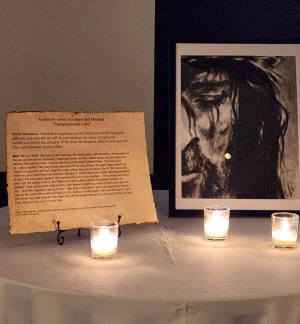
Station four had a painting title “Compassionate
Love” and represented the moment when Jesus was being judged and
mocked. The artist said he “wanted to emphasize Jesus’ solidarity
with the despised, afflicted and rejected, as well as communicate
his silent strength and confidence before his accusers.” Here,
people were asked to imagine they were there watching Jesus remain
silent, refusing to answer Pilate in response to the accusations
hurled at him. They were to think of what they might have said to
Pilate and others and how they respond when accused of something.

At station five, a passage in Luke 23:27-31 where
Jesus spoke to the women of Jerusalem is shown alongside a painting
called “The Art of Surrender.” People were asked to imagine
following Jesus on the way to the cross and reflect on what thoughts
and emotions they might have had. They were also asked what causes
them to weep and Jesus, the Man of Sorrows, can keep people company
in their sorrows.

Jesus’ crucifixion was represented by the painting ‘I
Have Overcome” at station six. For reflection, people were asked to
imagine being at the foot of the cross watching and listening to
everything unfold and consider how they would have felt. They were
to next imagine being one of the criminals next to Jesus and
imagining what they would say to Jesus and want Jesus to do.
Finally, they were to reflect on what words, actions or inactions of
Jesus speak most loudly to them.
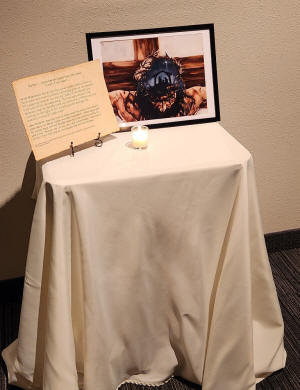
In John 19:25-27, Jesus spoke from the cross to his
mother and the disciple “whom he loved.” To his mother, Jesus said,
“woman, here is your son” and to the disciple, “here is your
mother.” It then says, “from that time on, the disciple took her
into his home.” At station seven, the painting “Love’s True Story”
showed Jesus on the cross and reminds the artist the “true light
shines in the darkness and the darkness will not overcome it.”
Here people were asked to picture themselves being at the foot of
the cross looking up at the bruised and bleeding Jesus then having
Jesus speak to them. It was also a place to reflect on being near
the end of their lives, consider who they would want to surround
them and the last words they would speak to loved ones.
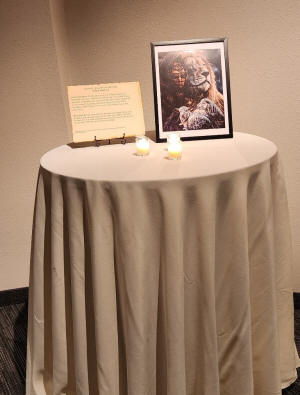
Station eight represented the moment when Jesus died
on the cross. In the painting “King and Shepherd,” the artist
depicted a lion and lamb as a reminder that Jesus is both the “king,
the Lion of Judah and the lamb who takes away the sins of the
world.”
For reflection, people were to imagine being at the foot of the
cross, watching the final moments of Jesus’ earthly life unfold and
consider what thoughts or emotions they would have had when Jesus
expressed his thirst, and a sponge of sour wine was lifted to Jesus’
parched lips. They were to then consider the tone of voice Jesus
might have used when he said, “It is finished” and reflect on the
meaning of these words. Finally, they were to ponder the words he
“gave up his spirit” and what the final act signified to them.

Each station asked everyone to end with [prayerfully] speaking to
God what they noticed during their time of reflection.
Before exiting the sanctuary, a table was set up for everyone to
take communion.
As people came out of the sanctuary, some were teary eyed from
reflecting on what Jesus went through and said it provided them a
truly emotional experience.
The Journey to the Cross was a good way to help people understand
and remember the true meaning of Easter.
[Angela Reiners] |